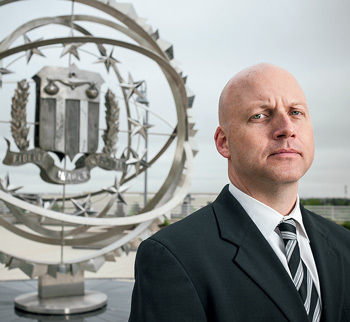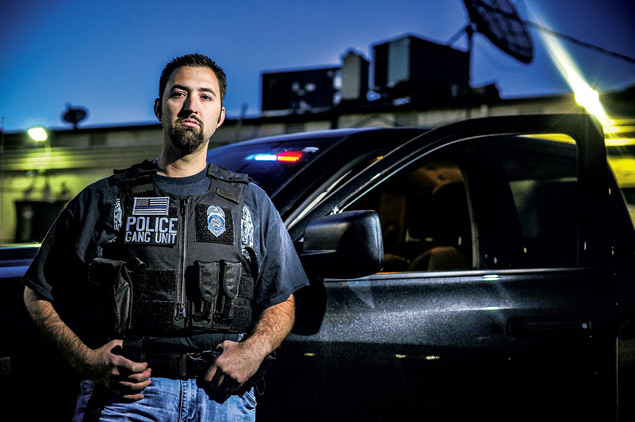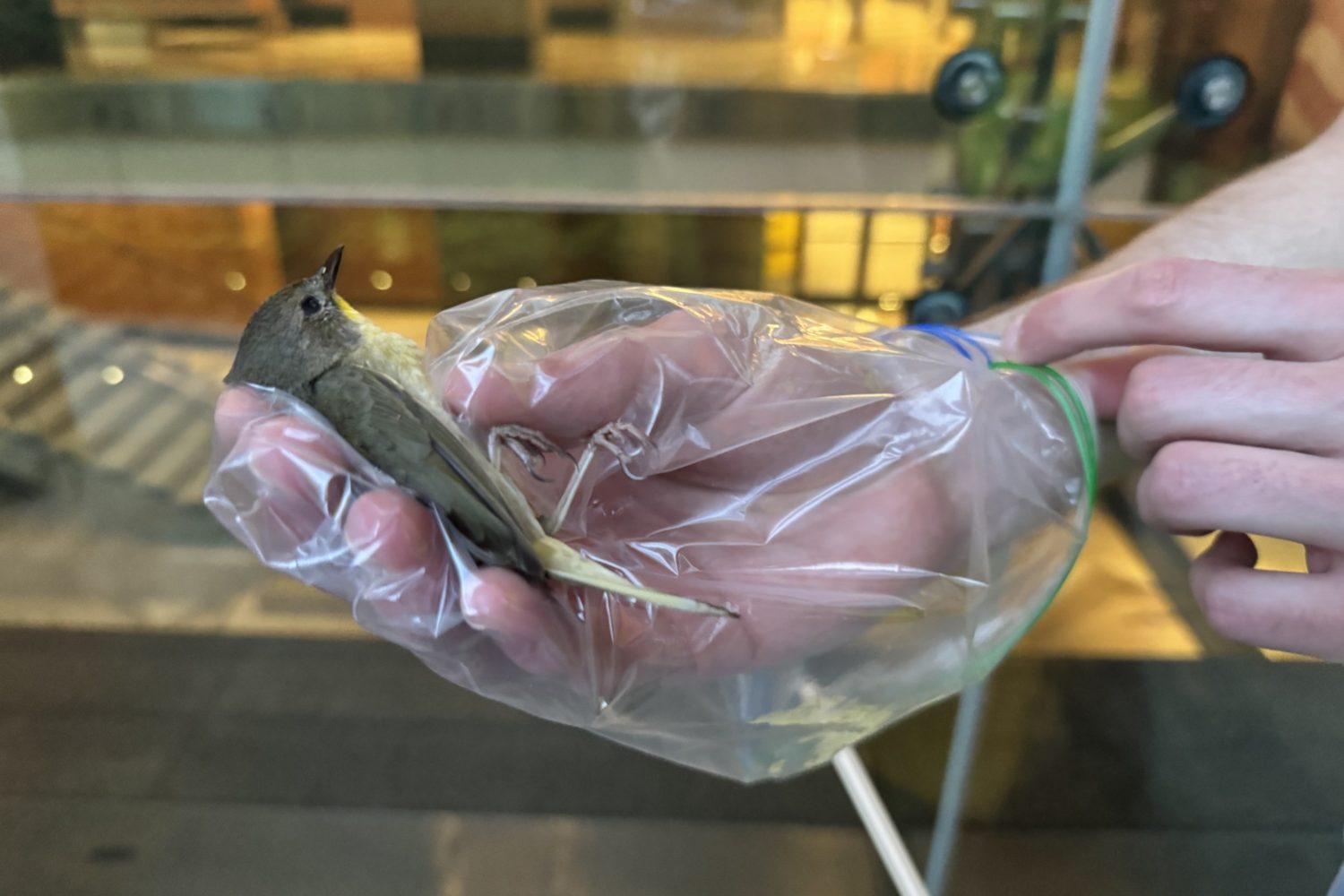If only Katie hadn’t responded to the Facebook message. That’s how her ordeal began in the summer of 2011—with a vague enticement from an unfamiliar name, Rain Smith.
“You’re pretty. You could make some money.” Those empty words had lured her into a stranger’s car.
It hadn’t been clear how she’d make money, and now Katie knew there was no “Rain Smith.” There was only the man in front of her—Justin Strom, a member of the Underground Gangster Crips gang in Fairfax County and the leader of a sex-trafficking operation.
Strom said he wanted to put her to work as a prostitute. Katie told him she was only 17 and not interested. He tried a different tactic, taking out a stash of cocaine and offering her some. She said she didn’t do that, somehow mustering the courage to slap his hand away.
She watched as the white powder dusted Strom’s lap. Then she felt her head slam into the car window.
• • •
One year earlier, in the fall of 2010, Detective William Woolf was tailing members of the gang MS-13 in an unmarked police car when he noticed something strange.
Woolf has a youthful smile. He wears sneakers and T-shirts, and when he cracks a joke, you can see how he might relate to the teenagers he meets on the job. Around the Fairfax County Police Department, he’s known as Billy.
Woolf had been working gangs in Fairfax County for four years. He had spent much of that time tracking MS-13, a Salvadoran gang that has a big presence around Washington.
Something was different this night. The men had a girl with them—she looked underage—and they appeared to be driving around aimlessly. Woolf watched as the girl got out of the car, entered an apartment building, and emerged about 15 minutes later. The pattern repeated a couple of times before Woolf felt certain about what he was seeing.
Detective William Woolf was tailing members of the gang MS-13 when he noticed something strange. The men had a girl with them, and they appeared to be driving around aimlessly.
He had no choice but to blow his cover. He and a federal agent who was with him went in and rescued the girl. She was 16 and being sold for sex.
Woolf had heard rumors from his street sources about gangs prostituting girls around Washington but had never seen signs of it firsthand. Soon, though, other MS-13 sex-trafficking cases would unfold in rapid succession.
One of the traffickers Woolf discovered that first night was Alexander Rivas, who admitted recruiting two underage girls as prostitutes and is now serving ten years.
There was also Jose Juarez-Santamaria, who prostituted a 12-year-old throughout DC, Virginia, and Maryland and let his friends rape her. He was sentenced to life in prison.
And a federal jury gave Rances Amaya, known for carrying a machete, 50 years behind bars for trafficking three teen girls.
But as Woolf pursued MS-13, another enterprise operated undetected.
Through social-media sites including Facebook and MySpace, investigators say, Justin Strom invaded homes in Fairfax County, Arlington, and Alexandria. He waited at Metro stops and trolled shopping malls. He even infiltrated the halls of Fairfax County public schools, some of the best in the country, where he used female students to lure classmates into his sex-trafficking ring.
Anywhere a teenage girl might be, Strom was lurking.
• • •
When you tell people you’re working on a story about child sex trafficking, the first question they ask is “Where?” They picture brothels in Bangkok or back alleys in some Eastern European country. Few guess it’s happening in places like Fairfax, the nation’s second-richest county, where families flock to raise their kids in quiet cul-de-sacs.
But since 2011, police and federal agents have taken down 28 juvenile sex traffickers in the eastern district of Virginia, most just outside DC, and have identified 41 victims—all of them American citizens, many from middle- or upper-class families.

In Northern Virginia, the problem stems from street gangs such as MS-13, the Underground Gangster Crips, and SUR-13. Only Southern California has had a similar number of gang-controlled child sex-trafficking cases.
Police and prosecutors don’t know whether this crime is new or has just gone undetected until recently. If a gang member gets pulled over with guns or drugs in the car, he’s busted. But there’s nothing illegal about having a girl in the passenger seat. Gang members tell the girls to wear normal school clothes—sweatshirts, jeans, backpacks—and they typically use the same girls for only a few weeks, to avoid drawing attention from police or parents.
Traffickers know whom to target: a girl at the mall who avoids eye contact when paid a compliment, an angry teen posting on Facebook that she hates her parents, a girl who can’t afford clothes trendy enough to fit in with the popular crowd.
Many of the girls have problems at home, and some have a history of sexual abuse. Others just lack self-esteem or feel ignored—regular teenage problems that leave them vulnerable to a skilled
manipulator.
And, as I learned when one girl called me to talk about her experiences with Strom, those who fit the legal definition of “victim” don’t always see themselves that way.
• • •
Billy Woolf partnered with FBI agent Jeff Johannes on an MS-13 sex-trafficking case in early 2011, and they’ve worked together ever since. When Woolf sees something in the field or gets a report about suspected trafficking that could rise to the level of a federal offense, he calls Johannes to loop in the FBI. The two see each other or talk by phone almost every day.
Johannes specializes in crimes against children, and unlike Woolf, he looks tough—burly and bald, with clear blue eyes and graying stubble. When he and I meet at the FBI’s Washington Field Office, he’s polite but guarded, careful about how much he can tell a reporter.
Johannes’s occupation requires reticence—a label on the office’s mini-blinds warns not to open them more than 45 degrees, lest anyone try to spy through them—but he softens when I ask why he chose such difficult work.
“It has its moments where it’s just nothing but pure sadness,” he says. Yet the rewards outweigh the heartache: “You can’t get any more black-and-white, good-versus-evil than when you’re involving kids.”
Woolf and Johannes have found an ally in US Attorney Neil MacBride, who oversees the region that includes Fairfax County. MacBride has made ferreting out traffickers one of his office’s top priorities.
Knowing that MacBride wants to take down sex traffickers as badly as they do motivates Woolf and Johannes. And MacBride has a powerful tool—the federal statute for sentencing juvenile sex traffickers is severe: It imposes a mandatory minimum punishment of ten years in prison and a maximum of life.

In November 2011, a Child Protective Services report landed on Woolf’s desk. According to police, a 17-year-old named Laura had confided to a school administrator that she’d been hanging out with a guy she called Jae, who paid her to have sex with men, and she wasn’t sure what to do. (Laura would later deny saying any such thing to anyone at school.)
Laura comes from money—her father runs a government-contracting firm. But her life hasn’t been easy. Her parents are divorced, and she says one of her sisters has schizophrenia and bipolar disorder and the other has been arrested on gun and drug charges. Laura herself has been in and out of rehab for cocaine and other drugs for years.
Woolf drove to Laura’s house, a 4,000-square-foot home in Fairfax Station, to talk to her and her parents. Laura told him she didn’t need help and wasn’t in danger. Her response didn’t surprise Woolf—he’d met other girls in her situation who refused to cooperate, often out of devotion to their persecutors.
“It’s very similar to domestic violence,” he says. “Because this trauma bonding occurs, there’s this loyalty.” That loyalty can be especially strong in gangs, he says, because they indoctrinate girls into believing they’re becoming part of a family.
Laura wouldn’t talk, but her parents handed over her laptop. Horrified, they told Woolf they’d do whatever they could to help the investigation and keep their daughter safe. When Woolf and Johannes examined the computer, they found that someone had logged onto Facebook from it using fake names, including “Rain Smith.” On Laura’s Facebook profile, she listed Justin Strom, nicknamed Jae, as her boyfriend.
Woolf recognized Strom, who was then 26 and had a long affiliation with the Crips. Strom had grown up in Fairfax County and gone to Robert E. Lee High School in Springfield but gotten involved with gangs early on. His criminal record included 11 juvenile offenses, and after he was stabbed in the stomach at age 18, he had the words thug life tattooed over the scar. Woolf had investigated Strom for robbery, assault, and drug dealing, but this was the first evidence he’d seen that the Crips were trafficking girls.
Just a week after Woolf met Laura, another 17-year-old, Meg,came forward. Her parents had been tracking her cell phone and saw that she was traveling to neighborhoods where she had no good reason to be. When they started asking questions, Meg confessed that Laura, one of her classmates, had recruited her into Strom’s prostitution ring, under his instructions. Meg’s parents called the police.
Meg gave Woolf and Johannes new clues into how Strom ran the operation, and she named men who worked as drivers and bodyguards for the girls. Woolf and Johannes found messages between Meg and Laura on Facebook that corroborated her account. In one exchange, Laura told Meg to call Strom for more details about how she could start making money.
• • •
Through Laura’s laptop, Woolf and Johannes found that Strom was advertising girls on Craigslist and Backpage.com. They got warrants for records from those sites. They also compelled Facebook to turn over records for the fake accounts Strom used. Those searches revealed the identities of girls Strom had contacted, giving Woolf and Johannes a long list of possible victims to interview.
Woolf and Johannes say predators such as Strom spend entire days trolling Facebook, looking for girls who post about fighting with their parents or feeling left out at school. They can detect when a girl has a void in her life they can offer to fill. Facebook has privacy settings, but plenty of kids leave their thoughts and feelings open for anyone to read.
From Strom’s “Rain Smith” Facebook account, a message had gone out to more than 800 girls: “You’re pretty. You could make some money.”
It was the same message that had popped up in Katie’s in-box in the summer of 2011, when she was 17. When Woolf and another Fairfax County detective tracked Katie down, she told them how those words had changed her life.
Katie went to high school and came from what Woolf would later describe as “a normal home.” But the prospect of making money had intrigued her. Woolf and Johannes say girls her age often are lured by a desire as trivial as wanting extra spending money for clothes.
Soon after Katie responded to the message, another girl—who turned out to be one of Strom’s prostitutes—picked her up. She drove Katie to meet Strom and two of his associates, Henock Ghile and Donyel Dove.
Katie found herself in a car with four strangers, realizing she had made a dangerous mistake. Strom and the others explained the plan to prostitute her, and Strom said she had to have sex with him and Ghile first, as a sort of initiation. Katie told detectives she pushed Strom’s hand away when he offered her cocaine and she saw the white powder spill all over his lap. Then her head hit the window.
She remembered how Strom had pulled her out of the car and led her around the corner of a nearby apartment building. How he had pressed a knife to her neck and demanded a blowjob. How she had felt sick and tried to refuse him. How he had sliced her across the forearm with the knife.
Woolf and partner Jeff Johannes found Facebook exchanges between Meg and Laura. In one, Laura told Meg to call Justin Strom for more details about how she could start making money.
The detectives noticed scars on both Katie’s arm and her forehead. Hospital records confirmed that a gash above her eye from that night had required stitches.
Before Strom finished with her, Katie told the detectives, he ordered her to stand and bend over. It was the first of 15 rapes she endured that night.
Strom then took Katie into the apartment building, where he forced her to have sex with 14 men, one after the other. She remembered that Strom was there for most of the rapes and that he collected $1,000 from the men.
In the early morning, Strom’s associates drove her home. They called her a “whore” and a “slut” and told her she’d gotten what she had coming. If she told anyone what had happened, they said, they’d come back and kill her.
• • •
Police also found Jessica, who told them she’d met Strom at the Franconia-Springfield Metro stop in the spring of 2009. Though commuters crowd the station during rush hour, it’s quiet in the middle of the day. Trees and underbrush surround the area.
Jessica, 16 at the time, said Strom approached her and told her she was pretty. He said she could make a lot of money by having sex with men, but first he “needed to see if it was good.” Jessica told detectives she was flattered by the attention. She agreed to have sex with Strom right there in the woods.
Jessica said she worked as a prostitute throughout the summer of 2009 in Virginia and Maryland and that Strom and his associates fed her a steady supply of marijuana, cocaine, ecstasy, and booze. She would go home and eat dinner with her family, then get high and go to work. She said Strom was violent and that when she told him she wanted out, he
grabbed her around the neck and squeezed hard. This wasn’t a job she could just quit.
Strom’s victims were helping Woolf and Johannes put together a disturbing profile of a man selling girls in 10-to-15-minute increments for anywhere from $30 to $100. He found a loyal clientele in neighborhoods such as Commerce Street in Springfield and Chirilagua in Alexandria. Just minutes from McMansions and tony shopping districts, these areas are home
to low-end apartment complexes targeted by child traffickers.
Strom was a pro at finding girls with poor self-esteem and manipulating them into doing—and thinking—whatever he wanted. He clearly knew how to elude law enforcement—he’d been running the operation undetected for years.

At 10 pm on Christmas Day 2011, Woolf’s phone started ringing. He was celebrating at home with his family, enjoying some rare time away from the job.
Laura’s parents had reported her missing in early December, and Woolf had spent weeks handing out his cell-phone number and information about Laura to motels around the area, in case an employee recognized her. Sure enough, one did.
Laura called me as I was reporting this story, and we talked about her time on the run with Strom. She said it was her idea to flee. First Woolf had come to her house, she said, and then police showed up at school to question her. She was worried.
“I’ve run away several times,” Laura said. “That’s all I know how to do. When something goes bad, I run.”
Laura told me Strom had received an unfair share of the blame, and she wanted to correct the record: “A lot of the girls said Justin did stuff that I did.”
She told me she’d dabbled in prostitution before she’d ever met Strom and that it was Strom’s friend Donyel Dove who introduced her to the trafficking ring.
“I’ve always been viewed as a ho,” she said. “Once you’re called something enough, it’s like ‘Well, I already am.’ ”
According to Laura, Strom—who became her boyfriend—never wanted her to sell herself. “Prostitution is kind of a relief,” she told me. “You get to be somebody else. You’re with a stranger that doesn’t know you, that doesn’t judge you. It’s kind of like an out-of-body experience.” She said the clients were men of all ages and races and she was never scared.
Laura wanted me to know she was the ring’s real leader, in charge of recruiting and selling the girls. But she was involved only for six months, and Strom’s operation spanned at least five years. Gangs often use one girl, whom they call the head bitch in charge, or HBIC, to manage the others, and Woolf and Johannes say Laura filled this role for Strom.
Laura told me she’d managed about ten girls and that none were totally innocent. She said they were free to quit at any time and they all helped recruit friends and classmates. They had “a lot of trauma” in their past and most of them had drug addictions, but she didn’t see many cases of prior sexual abuse. Rather, they had been ignored or excluded by their families.
“I think neglect is sometimes harder on people than abuse,” Laura said. She recalled a time when she accidentally burned her face on a cigarette and no one at home would help. Strom invited her over and treated the burn. She said he was like family to her.
As for Katie’s account of her brutal rape and assault, Laura said: “I don’t think any of that’s true.”
• • •
For three weeks, Laura and Strom had jumped from one motel to the next, going as far as Atlantic City and being careful not to stay more than one night at the same place. Laura turned tricks to help pay for their travels.
They wanted to relax over the holidays, so they settled into the Travelodge in Alexandria for three nights instead of their usual one. Located on a tidy, tree-lined street, the motel, though shabby, doesn’t look like a harbor for runaway girls.
Laura wanted me to know she was the ring’s real leader, in charge of recruiting and selling the girls. But she was involved only for six months, and Strom’s operation spanned at least five years.
On Christmas, Laura and Strom watched movies and cooked a stew for dinner.
“We got too comfortable,” Laura says. So when Woolf knocked, she wasn’t surprised. If she was going to be arrested, she wanted to have a cigarette first. She lit one, then let the police in.
For Woolf, finding Strom and Laura together was an opportunity to nail down an important piece of his case. “She’s a juvenile,” Woolf told Strom. “I’m recovering her because she’s a missing juvenile.”
Child sex-trafficking cases require investigators to prove that perpetrators knew, or had reason to know, that they were dealing with minors. Now that Woolf had told Strom that Laura was underage, Strom wouldn’t be able to deny later that he knew.
Laura was right to smoke that last cigarette, because Woolf took her with him. But he hadn’t caught Strom doing anything illegal in the motel room, and he and Johannes hadn’t finished building their case against him. Arresting Strom would have to wait.
• • •
Woolf and Johannes watched Strom closely as they continued to gather information from victims and follow his online trail. They installed a tracking device on a white Cadillac Seville that Strom and his associates used to drive girls around, and they began tracing the gang’s phone calls. When the gang attempted to put girls to work, investigators were there.
Strom brought three girls, including Laura, to an Alexandria neighborhood on Valentine’s Day 2012. He waited in a parked car while they stood on the side of the street.
Laura says they weren’t trying to find men that night—they only wanted to buy drugs—and that the outing had been her idea. Because it was Valentine’s Day, she says she wanted to go out to dinner and have a little fun.
Unbeknownst to her or Strom, Woolf was there, too, watching from an unmarked car. The girls weren’t finding any takers. About ten minutes passed before they climbed back into the car with Strom and started to pull away. Woolf—who was out of his jurisdiction and unable to make arrests—dialed the dispatch number for the Alexandria Police Department.
He told the operator who he was and what he was seeing and said he could direct Alexandria officers to Strom’s vehicle. He knew they wouldn’t be able to arrest Strom—nothing illegal had happened yet; the point was to prevent it from happening. Alexandria police showed up and pulled Strom over. They arrested Laura on an outstanding warrant for violating probation.
The same month, Woolf and Johannes sat down to interview Christopher Sylvia. Back in November, Meg had identified Sylvia as one of Strom’s drivers. Sylvia was in police custody after violating a protective order to stay away from an ex-girlfriend.
He admitted his involvement and specifically recalled driving Meg to meet men. He talked about Strom’s role, saying that at one point he asked Strom why he “messes” with young girls instead of adult women.
Woolf and Johannes had by now spent three months on the investigation, often pulling 80-hour weeks. They were building a strong case—one that could dismantle Strom’s entire organization.

In the predawn hours of March 28, 2012, a small enclave of townhouses on Rocky Gap Court in Lorton sat dark and quiet. The cookie-cutter homes, distinguishable by paint color and not much else, look like typical, middle-class suburbia.
Inside a cream-colored, three-story home, Strom was asleep. It was from this townhouse that Woolf and Johannes say Strom ran his trafficking business. He had brought many of his underage victims there—leading them past a KinderCare daycare center to his back patio door, which is obscured by trees—and invited men over to have sex with them.
Woolf and Johannes had by now interviewed ten of Strom’s victims and corroborated their stories. They finally had enough evidence to bring Strom down.
SWAT teams from Fairfax County Police and the FBI arrived at 6 a.m. They barged through the small front door, finding mattresses on the floor and condoms strewn about. At Strom’s sentencing, his lawyer would describe him as having lived in “a perpetual fog of alcohol and sex.”
Woolf and Johannes watched from the command center in the FBI’s office in Manassas as the arrest team apprehended Strom. They could see the action play out on flat-screen monitors and hear updates coming in over the radio.
At the same time, SWAT teams arrested Henock Ghile, one of Strom’s drivers, and searched the home of Michael Jefferies, who worked as a bodyguard for the girls. It was the first time the FBI had ever done a “takedown”—multiple, simultaneous arrests and searches—in a child sex-trafficking case. Strom and his associates all pleaded guilty.
The arrest team brought Strom to the FBI’s Manassas office, where Woolf finally had the chance to question him. Woolf says that when asked how many girls he had sold, Strom answered: “Too many to count.”
• • •
On September 14, 2012, prosecutors asked Virginia federal judge James Cacheris to sentence Strom to life in prison.
A stream of his victims and their family members stood up to describe the devastation Strom had left in their lives.
Jessica, now 20, told the court about the summer she was 16.
“I had been playing soccer, had good friends and a good relationship with my parents. . . .” she said. “The same day I met [Strom], I found myself, or lost myself, in the arms of thugs and hustlers. I was brainwashed into believing that having sex with men for money was normal, an everyday thing.”
She said she continues to struggle: “I have been in three rehabs, three hospitals, had a suicide attempt and outpatient treatments with multiple therapists. And even after all that, I still seem to feel broken, worthless, and unequal to society.”
Laura was at a rehab facility in Colorado, so she was unable to attend. She says she believes police sent her away to keep her from speaking in Strom’s defense at his sentencing—a claim Woolf calls “ridiculous.” He says Laura’s parents paid for her treatment at the facility and that a juvenile court had ordered her there for an unrelated matter.
Laura’s mother spoke in her daughter’s absence: “What Mr. Strom subjected my daughter and these other young girls to is the most degrading, despicable, inhumane act of depravity any parent can imagine.”
Meg’s father challenged the judge: “My marriage is failing; my family is failing. I failed my daughter. I hope you don’t fail us.”
Strom listened—even teared up—as the people who blamed him for ruining their lives spoke. Then it was his turn.
“I want to say to the families and the victims and to my family that I’m sorry for all the pain that I caused them,” he told the court. “I don’t want to blame it on drugs or alcohol, but it had a big part. . . . I ask God to forgive me. I ask for mercy. Your Honor, I just ask that you have mercy on me.”
To some extent, Judge Cacheris did. He gave Strom 40 years, not life. Strom spends his days now in a maximum-security prison in Victorville, California, on the edge of the Mojave Desert. His codefendants are also locked up. Donyel Dove got 23 years. Michael Jefferies, Christopher Sylvia, and Henock Ghile are each serving ten. (Attempts to reach Strom’s codefendants directly and through their lawyers were unsuccessful.)
• • •
This winter, I sent Strom a letter explaining that I was writing about his case and offering him the chance to comment. His response, two weeks later, stood out in my stack of mail. He had scrawled a quote from Martin Luther King Jr. (“Darkness cannot drive out darkness; only light can do that. Hate cannot drive out hate; only love can do that.”) on the back of the envelope along with the phrases “cold world” and “God is love.”
Given that Strom had pleaded guilty, signed a statement of facts admitting to the investigators’ findings, and said at his sentencing that he accepted responsibility and had ended his involvement in prostitution only a month before his arrest, I was thrown by what he wrote.
He claimed he hadn’t been involved in sex trafficking for “several years.” He said Katie, the girl who was raped 15 times, didn’t exist. He mentioned Laura and how she doesn’t consider herself a victim. He also wrote that he was in solitary confinement because “there’s said to be a hit out” on his life.
I wrote him back, asking why he would plead guilty and apologize if none of the allegations were true. In his response, he said his codefendants had conspired to “pin me as the leader” and that he pleaded because his lawyers told him he had no chance of winning.
He also changed his story from his first letter and claimed that he had never trafficked young girls. He again addressed the rape accusation, writing that he was “known for being a ladies man” and had no need to force himself on women.
Strom’s letters were littered with strange quotes and indecipherable Bible references. Laura had told me he’d introduced her to philosophy; maybe these rambling thoughts were Strom’s attempt to sound philosophical.
He sent me one more piece of mail. He’s married now, to the mother of some of his five children; the couple wed while he was in prison. But with this last letter, Strom included a photo of himself and Laura. She’s smiling and kissing his cheek. The angle indicates that one of them was holding the camera. As I studied it, I wondered if they’d taken the photo while they were on the run together over Christmas.
Laura is 18 now. She spent eight months in Colorado getting sober and participating in therapy for kids who have been sexually exploited. She says she became a leader among her peers at the treatment center.
“The staff saw me that way,” she says. “It made me feel good, just how people viewed me.”
She says she’s drug-free. She has a job as an administrative assistant and plans to start community college in August. She and her mother hadn’t had a relationship since she was 12, but now she says they e-mail and hang out.
But Laura remains loyal to Strom. She talks about how he may be able to appeal his case—unlikely, given his guilty plea. And though he’s married, when I ask her if she thinks they’ll reconnect one day, she doesn’t rule it out: “I don’t really know where we’re at or where we’re going to be in the future.”
I ask what advice she’d give to other girls. She says staying busy with something positive, like a sport, is important. Keeping out of trouble, she says, requires finding “a place to belong.”
I look at the girl—young and pretty—in the photo with Strom. I hope she’s found her place.
This article appears in the June 2013 issue of The Washingtonian.



















